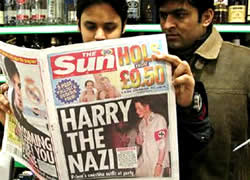EU Ban... The Swastika Today
In February 2005, the European Union dropped plans to ban the use of the swastika in its 25 member states. The proposal from German Conservatives, Liberals and Social Democrats in the European Parliament had been for the banning of all Nazi symbols, however, it proved impossible for member states to agree on which symbols should be banned and the proposal was dropped.

The controversy arose when Prince Harry, third in line to the British throne, wore a Nazi costume and a swastika armband to a fancy dress party. Prince Harry later apologised for any offence that was caused. The resulting proposal to introduce an E.U. wide ban on the swastika led to much discussion amongst different groups and organisations who use the symbol in their culture or religion.
Articles appeared in newspapers, on websites, interviews were held on radio stations and stories run on television networks, that revealed much about the long and diverse history of the swastika. It became clear from these reports that use of the swastika dates much further back than the Nazis, and that the swastika has been, and continues to be, part of numerous cultures around the world. Many of those cultures have members in Europe for whom the idea of banning the swastika is outrageous.
In January, 2007, the debate intensified as Germany seeked to use its EU presidency to launch an initiative which could lead to common laws across the bloc making it a crime to deny genocide and display Nazi symbols. Links: YNet News, BBC.
Dharmafly web applications